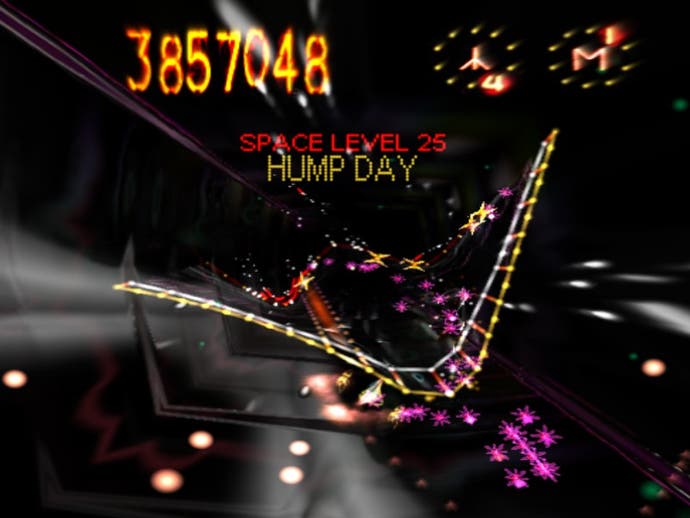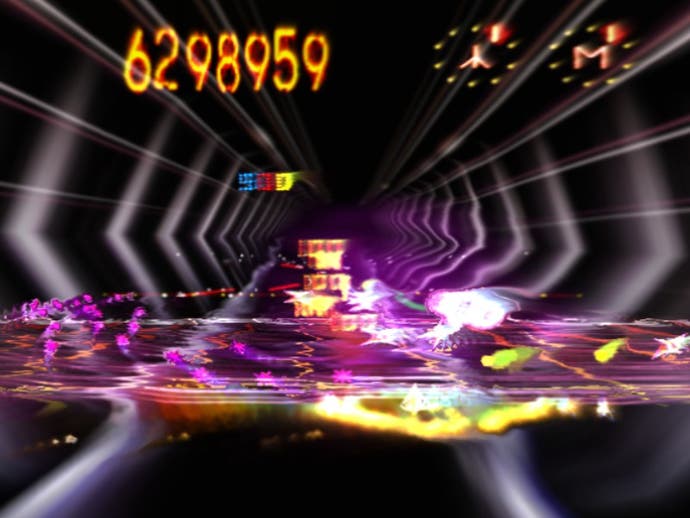Space Giraffe retrospective
In the zone.
Conversations about Space Giraffe tend to focus on how it looks. How it sounds is just as important, though. Every enemy, every shot, every single interaction with Jeff Minter's vivid and relentlessly busy tube blaster comes with its own distinct audio cue, from the escalating knife-on-a-wineglass chimes of a flower being trimmed, to the push-button beep of a sneeze bouncing back into the playing field. The more I play it, the more I've started to realise that Space Giraffe's ultimately about a weird form of triangulation - about zeroing in on the location of a threat by combining the imperfect data from your eyes with the imperfect data from your ears. This alone makes it one of the most exciting and original games ever created, if you ask me - and also one of the most divisive.
For example: many have noticed that, on a basic level, Space Giraffe isn't very fair, that it blinds you with the neon clouds and pools of dazzling colours generated by its designer's beloved light synths and then kills you while you're still blinking from it all. This misses the point, I think. Show me a good arcade game that is fair. Show me one that's about straight-up symmetry, anyway - and that still manages to make your heart race and your fingers tremble. Fairness is great if you've torn a rotator cuff at work and want a bit of compensation, but it's frequently boring in game design terms. From Defender to Galaga to Space Giraffe's great, great, great grandfather Tempest, arcade games are about being out-manned and often out-gunned - and there's no better feeling that really pummelling a game that lays things on thick. They swarm at you in great numbers, and you are just a single mistake away from oblivion: a great arcade game allows you to actually revel in the unfairness of it all. A really great arcade game offers you strengths that are entirely complementary to your weaknesses, too. And for Space Giraffe, that means bulling.
If you've never tried a tube shooter before, here's some quick orientation: in Space Giraffe, you play a stoic little coathanger of light sliding along the nearest edge of a piece of simple wireframe geometry. You're skating around the rim of a tube, or a plain, or a wonky shape that defies easy description. Enemies advance towards you from the horizon, switching between neat little lanes, and you can whittle them down with your shots. Here's the Space Giraffe twist, though: if they get to you and start to clamber along the rim with you - and if you still have your power zone, which is a barrier reaching out into the playing field, extended - you can ram into these enemies and finish them off en masse for gigantic scores. This is bulling, and it's wonderful. It's not easy to pull off - to keep the power zone from shrinking back to nothing you need to be moving and shooting or using one of your precious collectible pods - but it's more than worth it. The audio fragments as the wail of a screaming Spitfire engine soars over the soundtrack, livestock moos and bays in the distance, and your foes are scattered into golden light. A risk well taken - there's nothing quite like it.

Bulling would be great in any arcade game, but in Space Giraffe it's truly electrifying. With the screen descending into aneurysm territory, the colours warping and enemies moving towards a viable position - alongside deadly threats - bulling becomes in part - whisper it - an act of faith. This is where Space Giraffe really comes alive, and it's a dazzling piece of thinking on behalf of Minter and his colleague Ivan Zorzin: 1. Arcade games are all about precision. 2. What if we built on that precision with things that obscure it? 3. And then, what if we gave the very best players the tools to cut through all obfuscation and draw a clean signal out of the noise again? (4: Spitfire fx?) Everywhere you look, you see this back-and-forth sort of mentality at work, from collectable pods that provide useful powers but also advance in blinding pools of light, allowing enemies to sneak along with them unseen, to foes that, when shot, actually warp the background even more. Success in Space Giraffe almost always brings with it the likelihood of imminent failure. That's why it's so unusually sweet.
And bulling by itself is absolutely transformative. It's an indicator that Space Giraffe isn't so much inspired by Tempest as it's inspired by an attempt to turn its tube-shooter design inside out. If you're coming straight from Dave Theurer's classic - or one of Minter's loving reimaginings - it's going to take a heartening amount of time to get yourself oriented, in fact. You'll be used to shooting the enemies and dodging their shots while, in this particular undertaking, you're better of dodging the enemies and shooting their shots. You want the enemies to get in close to unlock their scoring potential. Their shots, meanwhile, are worth even more points if you can keep knocking them back whenever they come your way: when the end of the level arrives you can take them all in as sneezes and see your score race through the roof.
This is a shooter in which shooting things is a pretty complicated business, in other words, and your auto-firing guns are a curse as well as a blessing at times. They're good for knocking those bullets back into play, but their main use, as far as standard enemies are concerned, lies not with simply blasting baddies to pieces, but as a means of feeling outwards into a landscape you can't always see - sending out deadly radar pings, and seeing which sounds are returned.

That's a lot to keep in mind, even before new foes like guys that can only be killed when changing lanes, and new power-ups, like an ability to jump backwards off the rim, extending the power zone as you do so, come into the mix. And, when you inevitably fail, you'll realise that when Minter's at his best as a designer, this gentle curry-loving gent from Wales is actually a gleeful playground bully. It feels amazing to sweep along the edge of the screen, knocking enemies to pieces, so that's inevitably the one thing his design tries to obstruct. He sends out flowers that grow towards you and carve up the outer edge of the pipe. He saddles you with that power zone, so useful when it's extended (you can even use its area to curve your shots) and so dispiriting, so enfeebling when it's gone. Tempest always had territory control elements, but Space Giraffe puts them at the very centre of the experience. At a high level, the game's about managing threats well enough (and that, of course, means first identifying those threats from all the chaos raging around you) to allow you to then dance between them in an endless bulling spin, racing back and forth, around and around, as Spitfires descend, enemies turn to gas, and the score counter moves upwards in greedy hops.
In the end, the whole thing feels like a game about earning Minter's respect, which is astonishing since it came out in the golden era of Achievements, breadcrumb tutorials and general ludic ingratiation. You can play Space Giraffe tamely, ceding your space, and giving up on your god-given bulling rights, and you'll still survive, most likely. It's no kind of life, though, and each level will hand you a debriefing appraisal that's surprisingly hard to live with: You are unambitious. You are a bit rubbish. You are meh.
Don't be meh! Sit forward, lean into the lights, clear out your ears and try not to blink: Minter actually wants to bring you into the fold. That's why he offers so much feedback, even going so far as to provide a bar chart at the end of each game: Here's where you should be; here's where you actually are.

I love Space Giraffe because of that feedback, because of the bulling and the Spitfires and the glorious unfairness spinning at the heart of this astonishing and compact galaxy of sound and vision. I love it for the game's wonderful sense of a progression taking place within Minter himself. He's a designer who's gone from realising psychedelic backdrops can be a great enhancement to precise arcade gameplay and on to understanding that, sometimes, they can actually provide some of the gameplay themselves. Light can become fun.
Everyone's got a favourite level. Mine's 27: The Wrong Pill. It's a flat environment, essentially - a sheer cliff along which foes fall at staggering speed. The camera's not playing along quite as it normally does, though: you move back and forth, and your viewpoint swings in and out, describing a dramatic arc as the background turns from early Doctor Who time tunnel to Kubrickian stargate feedback loop. I'm listening intently, I'm making out what I can, I'm dodging the enemies and shooting the shots and I finally get the sense that the time is right. A jump extends the zone, and then I rush across the landscape, scattering enemies in every direction. Plane engines and ungulates descend in unison, and the screen gives way to blinding white.
And in that white I can just glimpse horns and a pair of bovine eyes staring back at me. You are semi-respectable..









